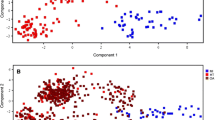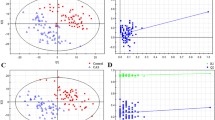Abstract
Type 2 diabetes mellitus (T2DM) and type 2 diabetic coronary heart diseases (T2DM–CHD) are directly associated with metabolism disorder of lipid. In the present study, GC–MS followed by multivariate statistical analysis has been successfully applied to plasma free fatty acid metabolic profiling in T2DM and T2DM–CHD. Because principal component analysis and partial least squares-linear discriminant analysis both failed to the class separation among T2DM, T2DM–CHD, and control, uncorrelated linear discriminant analysis (ULDA) was proposed and successfully discriminated these three groups. The predictive correct rates were 81.03%, 85.37%, 88.89% for control and T2DM, control and T2DM–CHD, T2DM and T2DM–CHD, respectively. Furthermore, three potential biomarkers were screened. ULDA are much more efficient than PCA and PLS for discrimination analysis of complex data set. It is undoubtedly that such newly multivariate analysis method will promote and widen the application of metabonome analysis in disease clinical diagnosis.




Similar content being viewed by others
Abbreviations
- FFA:
-
Free fatty acid
- GC–MS:
-
Gas chromatography–mass spectrometry
- FBG:
-
Fasting blood glucose
- PBG:
-
2 h Postprandial blood glucose
- T2DM:
-
Type 2 diabetes mellitus
- T2DM–CHD:
-
Type 2 diabetic coronary heart diseases
- PCA–LDA:
-
Principal component analysis–linear discriminant analysis
- PC:
-
Principal component
- PLS–LDA:
-
Partial least squares–linear discriminant analysis
- ULDA–LDA:
-
Uncorrelated linear discriminant analysis–linear discriminant analysis
- UDV:
-
Uncorrelated discriminant vector
References
Barshop, B. A. (2004). Metabolomic approaches to mitochondrial disease: Correlation of urine organic acids. Mitochondrion, 4, 521–527.
Beckwith-Hall, B. M., Brindle, J. T., Barton, R. H., et al. (2002). Application of orthogonal signal correction to minimise the effects of physical and biological variation in high resolution 1H NMR spectra of biofluids. Analyst, 127, 1283–1288.
Bergman, R. N., & Ader, M. (2000). Free fatty acids and pathogenesis of type 2 diabetes mellitus. Trends in Endocrinology and Metabolism, 11, 351–356.
Bernd, H., & Gerrit van, M. (2006). Lipidome and disease. FEBS Letters, 580, 5429.
Boden, G. (1999). Free fatty acids, insulin resistance, and type 2 diabetes mellitus. Proceedings of the Association of American Physicians, 3, 241–248.
Brindle, J. T., Antti, H., & Holmes, E., et al. (2002). Rapid and noninvasive diagnosis of the presence and severity of coronary heart disease using 1H NMR-based metabonomics. National Medicine, 8, 1439–1444.
Chen, M., & Hofestadt, R. (2006). A medical bioinformatics approach for metabolic disorders: Biomedical data prediction, modeling, and systematic analysis. Journal of Biomedical Informatics, 39, 147–159.
Dunckley, T., Coon, K. D., & Stephan, D. A. (2005). Discovery and development of biomarkers of neurological disease. Drug Discovery Today, 10, 326–334.
Diabetes Statistics. (1999). National diabetes information clearinghouse (pp 99–3926). Bethesda, Md: National Institute of Diabetes and Digestive and Kidney Diseases, NIH publication.
Fiehn, O. (2002). Metabolomics—the link between genotype and phenotype. Plant Molecular Biology, 48, 155–171.
Gavaghan, C. L.,Wilson, I. D., & Nicholson, J. K. (2002). Physiological variation in metabolic phenotyping and functional genomic studies: Use of orthogonal signal correction and PLS–DA. FEBS Letters, 530, 191–196.
Griffin, J. L. (2003). Metabonomics: NMR spectroscopy and pattern recognition analysis of body fluids and tissues for characterisation of xenobiotic toxicity and disease diagnosis. Current Opinion in Chemical Biology, 7, 648–654.
Holmes, E., & Antti, H. (2002). Chemometric contributions to the evolution of metabononics: Mathematical solutions to characterising and interpreting complex biological NMR spectra. Analyst, 127, 1549–1557.
Kell, D. B., & King, R. D. (2003). On the optimization of classes for the assignment of unidentified reading frames in functional genomics programmes: The need for machine learning. Trends in Biotechnology, 18, 93–98.
Laakso, M., & Lehto, S. (1997). Epidemiology of macrovascular disease in diabetes. Diabetes Review, 5, 294–310.
Miettinen, H., Lehto, S., Salomaa, V., Mahonen, M., Niemela, M., Haffner, S. M., et al. (1998). Impact of diabetes on mortality after the first myocardial infarction. The FINMONICA Myocardial Infarction Register Study Group. Diabetes Care, 21, 69–75.
Nicholson, J. K., Connelly, J., Lindon, J. C., & Holmes, E. (2002). Metabonomics: A platform for studying drug toxicity and gene function. Nature Reviews, 1, 153–161.
Oliver, S. G., Winson, M. K., Kell, D. B., & Baganz, F. (1998). Systematic functional analysis of the yeast genome. Trends Biotechnology, 16, 373–378.
Potts, B. C., Deese, A. J., Stevens, G. J., Reily, M. D., Robertson, D. G., & Theiss, J. (2001). NMR of biofluids and pattern recognition-assessing the impact of NMR parameters on the principal component analysis of urine from rat and mouse. Journal of Pharmaceutical and Biomedical Analysis, 26, 463–476.
Reaven, G. M., & Chen, Y. D. (1988). Role of abnormal free fatty acid metabolism in the development of non-insulin dependent diabetes mellitus. American Journal of Medicine, 85(suppl 5A), 106–113.
Ripley, B. D. (1996). Pattern classification and neural networks. Cambridge.
Sauter, H., Lauer, M., & Fritsch, H. (1991). Metabolic profiling of plants—a new diagnostic technique. ACS Symposium Series, 443, 288–299.
Singer, D. E., Moulton, A. W., & Nathan, D. M. (1989). Diabetic myocardial infarction: Interaction of diabetes with other preinfarction risk factors. Diabetes, 38, 350–357.
Stone, P. H., Muller, J. E., Hartwell, T., York, B. J., Rutherford, J. D., Parker, C. B., Turi, Z. G., Strauss, H. W., Willerson, J. T., & Robertson, T. (1989). The effect of diabetes mellitus on prognosis and serial left ventricular function after acute myocardial infarction: Contribution of both coronary disease and diastolic left ventricular dysfunction to the adverse prognosis. Journal of American College Cardiology, 14, 49–57.
Taylor, J., King, R. D., Altmann, T., & Fiehn, O. (2002). Application of metabolomics to plant genotype discrimination using statistics and machine learning. Bioinformatics, 18, 241–248.
The Expert Committee on the Diagnosis, the Classification of the Diabetes mellitus (1997). Report of the expert committee on the diagnosis and classification of diabetes mellitus. Diabetes Care, 20, 1183.
Tuomilehto, J., & Kuulasmaa, K. (1989). WHO MONICA project: Assessing CHD mortality and morbidity. International Journal of Epidemiology, 18, S38–S45.
Wagner, A. M., Martinez-Rubio, A., Ordonez-Llanos, J., & Perez-Perez, A. (2002). Diabetes mellitus and cardiovascular disease. European Journal of Internal Medicine, 13, 15–30.
Weckwerth, W., Tolstikov, V. & Fiehn, O. (2001). Metabolomic characterization of transgenic potato plants using GC/TOF and LC/MS. the 49th ASMS Conference on Mass spectrometry and Allied Topics, Vol. 1–2.
Wingard, D. L., Barrett-Connor, E. L., Scheidt-Nave, C., & Mcphillips, J. B. (1993). Prevalence of cardiovascular and renal complications in older adults with normal or impaired glucose tolerance or NIDDM: A population-based study. Diabetes Care, 16, 1022–1025.
Wyne, K. L. (2003). Free fatty acids and type 2 diabetes mellitus. The American Journal of Medicine, 115, 29–36.
Ye, J., Janardan, R., Li, Q., & Park, H. (2006). Feature reduction via generalized uncorrelated linear discriminant analysis. IEEE Transactions on Knowledge and Data Engineering, 18, 1312–1322.
Yi, L. Z.,He, J.,Liang, Y. Z.,Yuan, D. L., & Chau, F. T. (2006). Plasma fatty acid metabolic profiling and biomarkers of type 2 diabetes mellitus based on GC/MS and PLS–LDA. FEBS Letters, 580, 6837–6845.
Acknowledgments
This work is financially supported by the National Nature Foundation Committee of P.R. China (Grant No. 20475066) and the international cooperation project on traditional Chinese medicines of ministry of science and technology of China (2006DFA04090).
Author information
Authors and Affiliations
Corresponding authors
Rights and permissions
About this article
Cite this article
Yi, L.Z., Yuan, D.L., Che, Z.H. et al. Plasma fatty acid metabolic profile coupled with uncorrelated linear discriminant analysis to diagnose and biomarker screening of type 2 diabetes and type 2 diabetic coronary heart diseases. Metabolomics 4, 30–38 (2008). https://doi.org/10.1007/s11306-007-0098-7
Received:
Accepted:
Published:
Issue Date:
DOI: https://doi.org/10.1007/s11306-007-0098-7




